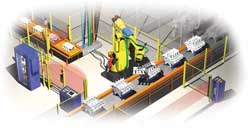
Posted to News on 1st Dec 2008, 12:29
Functional safety and how it can boost profits
This article from Rockwell Automation explains functional safety for machinery and argues that implementing functional safety can enhance a company's profitability.

The overall objective of functional safety is to protect workers by reducing incidents and to reduce the risk of loss and the costs associated with risk. Cost of risk is the sum of insurance premiums, claims administration fees, workers' compensation claims, risk management department costs (salary, travel, fringe benefits and so on), legal fees and other related costs such as assessments and consultants. Cost-of-risk expenses are measurable direct costs.
Functional safety benefits users by cutting costs, but not reducing safety. It provides users with a high safety-to-failure ratio so that they can maximise both production and safety.
Using functional safety and its applicable standards requires the availability of data such as probability of dangerous failure per hour (PFHd) and mean time to dangerous failure (MTTFd). This adds the time domain because functional safety enables the reliability of a safety system to be calculated. This should not be regarded as an absolute and certain value but more as an indicative and relative quantification that can prevent the use of unsuitable equipment.
Justification for functional safety
A white paper from Rockwell Automation outlines the long-term financial benefits manufacturers can reap by integrating comprehensive machine safety programmes into their workplaces as a form of insurance against potential risks. The Proving the Value of Safety white paper is linked from www.rockwellautomation.com/go/prsafety.
Like a travel passport that authorises the holder to travel internationally, a control system that uses a functional safety concept gives you a 'passport to safety'. That is because a system using functional safety meets international safety standards, making the system compliant with safety standards applicable in most nations. As a result, the manufacturer significantly increases global market opportunities to sell the machine to new customers.
Functional safety explained
Functional safety is the part of the overall safety implementation that depends on the correct functioning of the process or equipment in response to operational safety inputs. It relates to the physical operation of a machine or process. In other words, functional safety equals the confidence in the ability of the safety-related control system to perform its function over a specified time period.
The name 'functional safety' is often associated only with programmable safety systems, but this is a misconception. It covers a range of devices, such as interlocks, light curtains, safety relays, safety PLCs, safety contactors and safety drives that are interconnected to form a safety system.
An example of functional safety is an over-temperature protection device using a thermal sensor in an electric motor's windings to de-energise the motor before it can overheat. The thermal sensor performs a function, or action, to help provide safety.
Or consider this example: compare fixed physical guarding to electrically interlocked guarding. The physical ('hard') guarding is not considered functional safety. Although the fixed guard does perform a safety function "" keeping people out and materials in "" it is not considered to be 'functional safety' because there is no input to a system. The interlocked door, however, is an example of functional safety. When the guard is opened, the interlock serves as an input to a system that assures a safe state is achieved.
Risk reduction
Functional safety falls under the umbrella of the risk reduction process. The risk reduction process involves these steps:
- Eliminate by design using inherently safe design concepts
- Safeguarding and protective measures with hard guarding and safety devices
- Complimentary safety measures including personal protective equipment (PPE)
- Safe working practice achieved with procedures, training and supervision
Functional safety addresses the safeguarding portion of the risk reduction process. When integrated safety is implemented by means of systems designed so that safety and environmental considerations are fundamental elements of doing work, functional safety measures are included as part of the safety system.
Hazard analysis and risk assessment
Performing a hazard analysis and risk assessment is the first step in the safety life cycle, which has five steps:
- Risk assessment or hazard analysis
- Safety system requirements
- Safety system implementation
- Safety system validation
- Maintaining and improving the safety system
Functional safety is part of the safety life cycle because it is involved in steps 2, 3 and 4.
When designing equipment and associated control systems, a hazard analysis will help determine whether functional safety is necessary to ensure adequate protection against each significant hazard. If so, then users can integrate functional safety into the machine design requirements, implementation and validation.
A hazard analysis identifies what has to be done to avoid hazardous events associated with the operation and maintenance of the machinery. In addition, a risk assessment gives the safety integrity required of the safety system for the risk to be acceptable.
Finally, don't forget to download the White Paper Proving the Value of Safety.






























